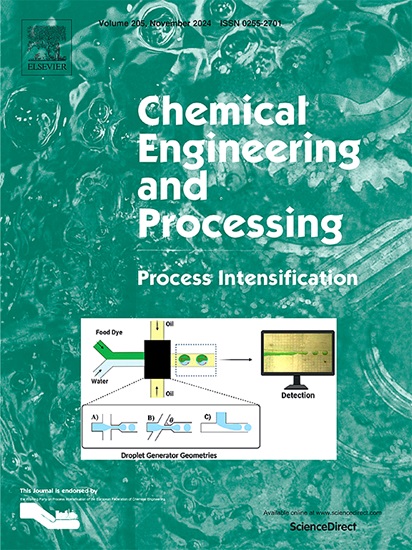Intensification of delignification using steam explosion combined with enzymatic hydrolysis for enhanced fermentable sugar production
IF 3.8
3区 工程技术
Q3 ENERGY & FUELS
Chemical Engineering and Processing - Process Intensification
Pub Date : 2025-01-16
DOI:10.1016/j.cep.2025.110177
引用次数: 0
Abstract
Soybean hull is an agro-industrial residue widely generated due to the high productivity of soybean. This residue has high holocellulose content, which makes it feedstock for the production of fermentable sugars through the enzymatic hydrolysis process. This study evaluated the enhancement in fermentable sugar production from soybean hull through pretreatment by steam explosion before enzymatic hydrolysis. The steam explosion was evaluated by varying the reaction time of 2.5, 5, and 10 min at 180 °C and 5 MPa. Enzymatic hydrolysis was assessed from the activity of the enzyme filter paper unit (15 and 30) and load of the soybean hull in natura and soybean hull pretreated (1 % w/v and 2 % w/v). The results showed that steam explosion produced fermentable sugar (3.88 g/ 100 g), a difficultly quantified and reported result, in addition to recalcitrance reduction of the biomass, intensifying the total sugar yield in enzymatic hydrolysis. The highest sugar yield in enzymatic hydrolysis with soybean hull pretreated was 97.55 g/ 100 g, at 15 enzyme filter paper unit and 1 % load of the soybean hull. Steam explosion and enzymatic hydrolysis combined produced a maximum of 101.43 g/ 100 g, about 2.72 times than only enzymatic hydrolysis under the same conditions.

求助全文
约1分钟内获得全文
求助全文
来源期刊
CiteScore
7.80
自引率
9.30%
发文量
408
审稿时长
49 days
期刊介绍:
Chemical Engineering and Processing: Process Intensification is intended for practicing researchers in industry and academia, working in the field of Process Engineering and related to the subject of Process Intensification.Articles published in the Journal demonstrate how novel discoveries, developments and theories in the field of Process Engineering and in particular Process Intensification may be used for analysis and design of innovative equipment and processing methods with substantially improved sustainability, efficiency and environmental performance.

 求助内容:
求助内容: 应助结果提醒方式:
应助结果提醒方式:


